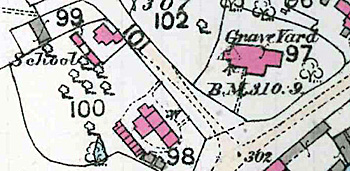Knotting School

Knotting School on a map of 1884
Volume II of The Victoria County History for Bedfordshire was published in 1908 and states that Knotting School was built in 1858. It was constructed at the expense of the Duke of Bedford, who, as Lord of the Manor, owned land in the parish and built estate houses for his tenants. It was sited just west of the church.
The first Education Act was passed in 1870 (more correctly it was known as the Elementary Education Act). It was a milestone in the provision of education in Britain demonstrating central government's unequivocal support for education of all classes across the country. It also sought to secularise education by allowing the creation of School Boards. These were groups of representatives, elected by the local ratepayers and the Board had the powers to raise funds to form a local rate to support local education, build and run schools, pay the fees of the poorest children, make local school attendance compulsory between the ages of 5 and 13 and could even support local church schools, though in practice they replaced them, turning them into Board run schools (known as Board Schools). Naturally, and luckily for local historians, the Act required a questionnaire of local schools in 1870. The entry for Knotting states: “School without the district, but available for it” indicating, presumably, that it was run on a voluntary basis.
The Factory and Workshop Act 1878 required numbers of children at schools to be tabulated. For the four weeks ending 12th September 1879 the school had been open 19 times with an average attendance of 30 of the 39 children on the books. The breakdown of the children by age was as follows [ref: E/SA3/1/1]:
- Under 5: 5 boys, 5 girls;
- 5-10: 15 boys, 8 girls;
- 10-14: no boys, 6 girls;
- Over 14: none.
In 1882 the Duke of Bedford’s estate in Knotting was conveyed to Charles Magniac of Colworth House, Sharnbrook . the estate comprised 1,551 acres, 31 poles and included the school, the price was £42,500 [ref: X547/24]. In 1892 Charles Whitbread, one of the duke’s trustees brought an action against Magniac for non-payment, alleging that £38/871/1/11 was due to him [ref: X547/32-35]. The following year Magniac was adjudged bankrupt and the estate was conveyed to Samuel Whitbread [ref: X547/36].
A land mark Education Act was passed in 1902, coming into effect in 1903. It disbanded the School Boards and gave day to day running of education to newly formed Local Education Authorities, usually the county council, as in Bedfordshire. The old Board Schools thus became Council Schools whilst the old National, British and other non-Board schools became known as Public Elementary Schools.
In 1903 a report was made by the managers of the school [ref: E/SA3/1/2] which stated that there were 35 children on the books and that the school buildings belonged to Samuel Whitbread of Southill Park. Kelly’s Directory for 1903 tells us that there was accommodation for 46 children, with average attendance of 16 and that the mistress was Mrs Emma Mary Stafford. The next Kelly’s for the county, 1906, does not mention the school and neither does any subsequent directory. The school is described in the survey of school premises undertaken in 1904, when a total of £50 needed to be spent on it to bring it up to standard. It may have been this that prompted the closure of the school. The buildings were subsequently demolished.